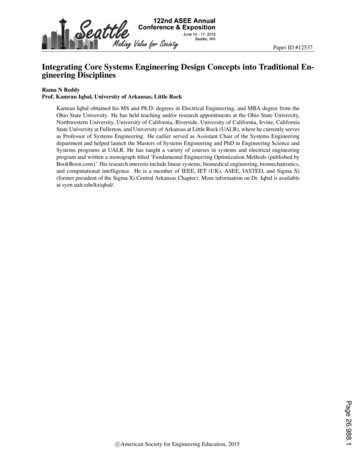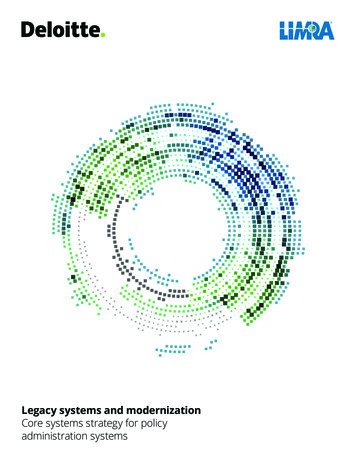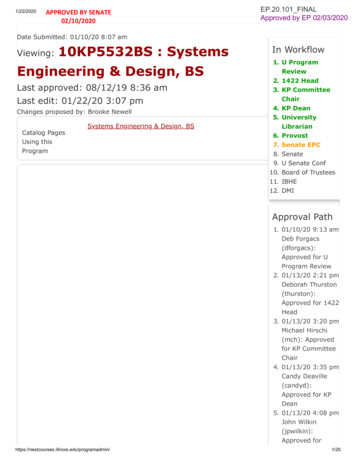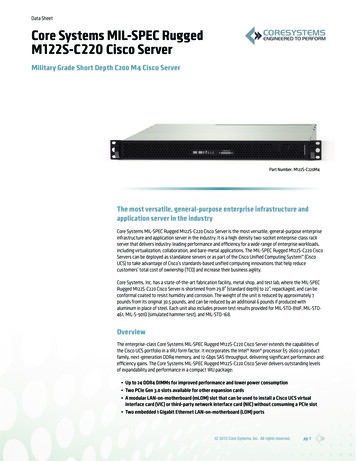
Transcription
Paper ID #12537Integrating Core Systems Engineering Design Concepts into Traditional Engineering DisciplinesRama N ReddyProf. Kamran Iqbal, University of Arkansas, Little RockKamran Iqbal obtained his MS and Ph.D. degrees in Electrical Engineering, and MBA degree from theOhio State University. He has held teaching and/or research appointments at the Ohio State University,Northwestern University, University of California, Riverside, University of California, Irvine, CaliforniaState University at Fullerton, and University of Arkansas at Little Rock (UALR), where he currently servesas Professor of Systems Engineering. He earlier served as Assistant Chair of the Systems Engineeringdepartment and helped launch the Masters of Systems Engineering and PhD in Engineering Science andSystems programs at UALR. He has taught a variety of courses in systems and electrical engineeringprogram and written a monograph titled ’Fundamental Engineering Optimization Methods (published byBookBoon.com).’ His research interests include linear systems, biomedical engineering, biomechatronics,and computational intelligence. He is a member of IEEE, IET (UK), ASEE, IASTED, and Sigma Xi(former president of the Sigma Xi Central Arkansas Chapter). More information on Dr. Iqbal is availableat syen.ualr.edu/kxiqbal/.Page 26.988.1c American Society for Engineering Education, 2015
Integrating Systems Engineering Concepts in all Design OrientedCourses in the Engineering CurriculumUniversity of Arkansas at Little Rock, 2801 S. University Ave., Little Rock, AR 72204Systems engineering is an interdisciplinary field of engineering that focuses on how to designand manage complex engineering systems over their life cycles. This study makes a case forintroducing core systems engineering concepts in undergraduate courses across engineeringdisciplines. We argue that rapid advances in technology, increasing complexity of engineeringprojects, lack of protection in a globalized world, and the pressures of reduced time to markethave all created a need for a greater understanding of systems engineering concepts, which mustnow be introduced at early stages of engineering curriculum. These practices would enhancepreparedness and marketability of engineering graduates into the twenty-first century work force.Systems engineering is a relatively new approach to the design of large and complex engineeringsystems. The engineering community and the aerospace industry initiated this new approach tothe design of large systems in 1960s. As the systems became large and complex the conventionalengineering design approach for such systems was not adequate. There were questions about thecost, schedule, and performance issues for the entire life cycle of such large systems. Theprimary issues addressed in this change of focus were to reduce cost, develop reasonabledelivery schedules, and increase performance. The systems engineering approach not onlyconsidered the design phase of the system but also all other phases of the systems life cycleincluding development, deployment, upgrades, maintenance, disposal, and training. Thus, thesystems engineering approach is considered as the concurrent engineering or the life cycleengineering approach. The industries involved in the design and deployment of large-scalesystems estimate that the systems engineering approach contributes to a saving of 6% to 8% ofthe total cost as well as increased performance and reduced scheduled delivery time in theoverall life cycle of the system.The authors feel that the systems engineering approach needs to be introduced in engineeringcourses that involve the design of projects. Engineering systems design and analysis mostlyrequires the use of Newtonian mechanics including: solid mechanics, fluid mechanics, and lawsof thermodynamics. The systems engineering approach prepares the students in design anddevelopment of engineering systems from the perspective of concurrent engineering or life cycleengineering. The design of complex systems such as automobiles, airplanes, space vehicles,power plants, and large ships may be used to give a feel to the students for the application ofsystems engineering design approach.Page 26.988.2The systems engineering approach to design is to consider the entire life cycle phases of thesystem under consideration. The life cycle phases must be considered concurrently during thedesign process. The design of any system starts with the conceptual design where top levelrequirement or requirements must be specified. For software systems the top level requirementsmust include all the required inputs, controls, and outputs. For hardware systems the top levelrequirements must include all the inputs, controls, outputs, and mechanisms. These requirementsmust be thoroughly understood and iterated to make sure they are completely specified. Thisrequires a thorough understanding of the system and its life cycle phases.
The next step is the preliminary design where the design and decomposition process is repeatedlyiterated to make sure that the design is complete and thorough. In the systems engineeringapproach, there is abstraction in concepts at the top level; then, as the design and decompositionprocess continues to the next level the abstraction decreases and the details emerge. As theprocess of design and decomposition continues to further levels, the abstraction graduallydisappears and details emerge. Once the design and decomposition process is complete theengineering team can see a clear picture of the system with all of its details. In the next designstage, the discipline engineering teams start designing the system configuration items, elements,components, small segments, large segments, top-level major segments, and the system.Once the design process at configuration item level is complete, the integration process begins.During integration process the configuration items are integrated to build elements, these must betested for verification to validate the elements. This process continues until all the segments andmajor components have been completely built and integrated to define the system. Theverification process at each step of integration leads to the validation. The verification andvalidation process is necessary to make sure that the system is built right. The last step in thedesign process is to formulate an acceptance test to make sure the right system is built thatsatisfies the stakeholder requirements.The system to be designed under consideration must be clearly and completely defined withstakeholder’s requirements in mind. The stakeholders, the management team, and the systemsengineering team together must consider the cost, schedule, and performance constraints. Thefeasibility studies will be conducted to make sure that the stakeholders, management, and thesystems engineering team agree on the feasibility of developing the system under consideration.Based on the discussion of all the parties involved a very important document must be written;the document is called the stakeholder’s requirements document (SRD).Based on the SRD the systems engineering team translates its contents in engineering andtechnical terms. The system under consideration may require scientific and mathematicalmodels. The systems engineering team design the system starting with the conceptual design,preliminary design, and the final design that satisfies the stakeholder’s requirements. A designdocument called Engineering Requirement Document (ERD) is prepared. This document isprepared in consultation with the stakeholders, management, and the systems engineering team.This document must be approved by all parties involved in developing the system.The decomposition, design, integration, and verification process is shown in Fig. 1. Thisrepresents the famous “Vee” model [1], where the decomposition and the design are shown bydownward arrows, and the integration and verification process are shown by upward arrows. Thedecomposition, design and the integration and verification process is shown in the figure.Page 26.988.3
Fig. 1: The systems Engineering ‘Vee’ model [1]The design process starts with the specification of all inputs, controls, outputs, and mechanismsat the top level to satisfy the system requirements. During the design process all of the “lifecycle” phases must be considered; this is also referred to as “concurrent engineering” process.The design process starts with the development of functional architecture followed by thephysical architecture, and then the allocated architecture. These architectures look as though theyare separate and distinct, but they are not. All of these architectures must be considered inparallel to see how they complement each other in the design of an engineering system. Further,each of the three architectures must be iterated to develop a successful design. We will nowconsider individual architectures and how it contributes to the overall design process.Page 26.988.4As stated above, the first step in the design process is to develop a functional architecture. At thetop level of the functional architecture we state the need and the requirements for the system withthe consultation of the stakeholders. Based on the need and the system requirements, we thenfigure out all the necessary inputs, controls, outputs, and mechanisms to achieve the stated need,purpose, and the requirements. This may require several iterations to make sure all of thepossible inputs, controls, outputs, and mechanics are in place to design the system. At presentthe systems engineering uses the TTDSE (Traditional Top-Down Systems Engineering), aconcept that originated from software engineering design and development.
In the functional architecture, we divide the top level engineering system into its majorsubsystems. The subsystems at this level are abstract except for the functionalities void of anydetails. This process of decomposition continues until all the abstractions gradually disappearand details emerge. The decomposition process results in major segments at the top level andthese segments are further divided in sub-segments. The segments and sub-segments are furtherdivided in the next level to elements and further into sub-elements. The elements are dividedinto components and sub-components. This process continues until the decomposition iscomplete and the components at the bottom level cannot be divided any further. These bottomlevel components called Configuration Items (CI’s). These CI’s cannot be divided any further.After the functional architecture has been completed, systems engineering design process iscomplete from the perspective of functional design. This is the first step in the design processfrom the perspective of application of system engineering design principles.A generic template for representing the physical system architecture is presented in Fig. 2 [1].This template suggests the creation of a generic partition of six system functions that are [2]: User interface: those functions associated with requesting and obtaining inputs fromusers, providing feedback that the inputs were received, providing outputs to users, andresponding to the queries of those users Input Processing: those functions needed to receive inputs from external interfaces(nonhumans), and other nonhuman system components and to process those inputs toput them into a format needed by the system's processing functions The process model: transform inputs into outputs: the major functions of the system Control processing: those functions needed to control the processing resources or theorder in which these processing functions should be conducted Output processing: those functions needed to convert the system's outputs into theformat needed by the external interfaces or other nonhuman system components andthen place those outputs onto the appropriate interface Provide structural support, enable maintenance, conduct self-test, and manageredundancy processing: those functions needed to perform internal support activities,respond to external diagnostic tests, monitor the system's functionality, detect errors,and enable the activation of standby resourcesUser Interface ProcessingProcess ModelInputProcessingControl ModelOutputProcessingFig. 2: The functional system architecture development model [1, 2].Page 26.988.5Maintenance, Self-Test,and RedundancyManagement Processing
Design Case StudyThis case study is to illustrate the concept of functional architecture, which is the first step in thedesign of engineering systems. The case presented in this paper is the design of a “lawn mower.”The functional decomposition process begins with the specification of the top level requirementwhich is “cut the grass”. This requirement be written in the top level box of the functionalarchitecture. This top level box must contain the information about all the possible inputs,controls, outputs, and mechanisms. These requirements are derived from the complete andthorough analysis of all the input, controls, outputs, and mechanisms requirements. Thisdocument must be prepared by the systems engineering team together with the stakeholdersinvolved in this design of this system. Figure 3 shows the top level box indicating the designrequirement.ControlsInputsLawn mowerto cut grassOutputsMechanismsFigure 2: The top level requirement diagram for the design of a lawn mowerThe top level functionality of the system is divided into the following functionalities that arefurther divided into sub-functionalities (Fig. 4):1. Cutting functionality2. The power requirements functionality3. The moving functionality with the chasee and the wheels4. The disposal functionality5. The other function like the paint and so onThe next step in the design process is the physical architecture. In this step the functionalarchitecture is translated or mapped into physical architecture. The first step in developing thephysical architecture is to map the functions into physical entities that perform those functions.The best mapping is a one-to-one mapping. The physical architecture is a two-step process: thefirst step is to develop the generic physical architecture from the functional architecture; thesecond step is to develop the instantiated physical architecture.Page 26.988.6
Lawn mower(cut the grass)cutting functionpower functiondrive functiondisposal functionsafety and casingfunctionscutting actionlow pwermanual operationbag the grasscasingblademaintenancehigh powerautomaticoperationleave behindcolorFigure 4: Functional architecture of the lawn mowerEach generic component or components, generic element or elements, and so on, are selectedfrom several choices for each of the generic components based on the design criterion. This isaccomplished by using morphological box. A morphological box is a two-dimensional matrixwhere the generic physical entities are represented in vertical columns and each of theinstantiations for each generic entity in each column are represented in horizontal rows. This is avery convenient method for mapping the functions to physical entities.The functionalities developed in the functional architecture (Fig. 4) for a lawn mower must bemapped into the physical entities. The functional architecture give the generic description of thephysical entities corresponding to the functions. In this design of a lawn mower the functionaldesign results in a generic physical architecture. There are different blade sizes, different enginepowers to power the lawn mower, different chases, different moving mechanisms, differentdepth of cutting adjustments, different paint colors. The generic lawn mower system withdifferent choices is represented by a morphological box as shown in Table 1.Table 1: A morphological box for a lawn mowerMover TypePaintColorredgreenblack3Page 26.988.7Blade Size (inches) Engine Power Depth of Cut(hp)(inches)Motorized mower222.52Manual mower243.03283.54368.54810.520.0#Choices: 2563
These choices give us 540 combinations, but when you are looking for a lawn mower you onlysee a few choices. The engineers who design this lawn mower have to make decisions about theviable choices keeping in mind the end users, manufacturers, maintenance, and the weight of themover in mind. For example, a viable choice for a manual lawn mower may be 22 inches to 24inches blade size, a horse power of 3.0 to 3.5, a depth cutting adjustment of 2 to 3 inches, and acolor choice of red, green, or black.These two architectures must be developed in parallel to keep the checks and balances betweenthe two architectures to eliminate the problems in the design of the system. The next step in thedesign process is to develop the allocated architecture where the physical entities are allocated tofunctions. This step must also be considered during the functional and physical architecturedevelopment to eliminate the problems that may show up during the allocation process of theallocated architecture. During the allocation process one must consider the interfaces betweenthe hardware segments, elements, components, configuration elements. The design of interfacesis very critical to entire design process.The interface is the physical or logical connection between the segments, elements, components.There are external interfaces and internal interfaces. In the design of engineering systems thesystem engineers are primarily concerned about the design of internal interfaces. The interfacesmust be considered during the development of the functional architecture. The functionsnecessary for the interfaces must be considered during the development of functional andphysical architectures. The interface is not only the physical connection, but also communicationand transportation connection among subsystems. Through the interface connection there ismaterial flow, energy flow, information flow, and data flow. Interfaces are critical for thesystem to function properly, effectively, and economically. Interfaces must be loosely coupled sothat the components, element, and segments can be easily replaceable when they malfunction, orget damaged during the operations. During the transportation of energy, materials, information,and data the interfaces must deliver them in the specified time without modification.To recapitulate, there are four major steps in developing a system. These are: functionalarchitecture, physical architecture, allocated architecture, and interface architecture. The firststep is to develop the functional architecture. During the development of functional architecturethe top level requirement must be specified based on the need of the stakeholder or the customer.There are two major steps in developing the physical architecture. First, one should develop thegeneric physical architecture in general terms, and then develop the instantiated physicalarchitecture with details for each of the generic physical entities. This is accomplished throughthe morphological box where each generic component is selected from several instantiatedhardware elements, For example aircraft wing is generic component and the instantiated wing isselected based in the options available and requirements of the aircraft under wing. The optionsavailable in the morphological box may be selected based on the requirements such as the size,lift, and other characteristics. This is done in the allocated architecture. The interfaces must beconsidered by doing the interface architecture.Page 26.988.8
Integrating Systems Engineering Methodology in Engineering EducationThe systems engineering design process offers a methodology that is broadly applicable to allengineering disciplines. Thus, the authors’ view is to introduce system engineering designmethods and principles in engineering courses offered to mechanical, electrical, civil, chemical,and petroleum engineering students. This is particularly important in senior design projects andother design oriented cours
as Professor of Systems Engineering. He earlier served as Assistant Chair of the Systems Engineering department and helped launch the Masters of Systems Engineering and PhD in Engineering Science and Systems programs at UALR. He has taught a variety of courses in sys











